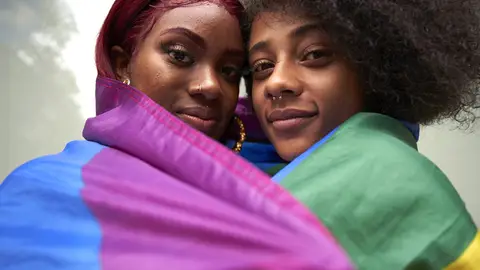Here's How You Can Best Support Bi+ Youth, According to The Trevor Project

The nation's leading suicide prevention group for LGBTQ youth is honoring Bisexual Awareness Week with a new resource tailored to the bi+ community.
The Trevor Project has unveiled its first-ever How To Support Bisexual Youth guide. The 10-page document breaks down everything you need to know about bisexuality, including what the sexual orientation is and isn't, how newly out bi+ people can explore their sexual orientation, and what non-bi+ people can do to prevent bisexual erasure or biphobia.
Its release coincides with the first day of Bisexual Awareness Week, a.k.a. #BiWeek, which culminates next Wednesday, September 23 on Bisexual Visibility Day.
Bisexuality is extremely common. As NewNowNext reported in January, the Williams Institute at the UCLA School of Law estimates that half of all LGBTQ Americans are attracted to people of more than one gender (read: multisexual, not monosexual).
Still, many harmful myths persist around being bi+. Some people who are monosexual—including gay men or lesbians, who, like straight people, are only attracted to people of one gender—insist that being bi is "just a phase," or deny the validity of bisexuality entirely. It's no surprise, then, that bi+ people are six times more likely to remained closeted than gay or lesbian people. One Australian study from 2018 even found that bi+ men are the least likely of all members of the LGBTQ community to come out.
To combat biphobia in everyday life, The Trevor Project's guide advises "[challenging] biphobic assumptions in our everyday lives."
"If you assume that a person is gay or straight based on their current relationship, work to reframe your understanding that the people in that relationship could be of any gender or sexual orientation," it reads in part.
The guide also highlights the unique challenges bi+ youth encounter:
According to The Trevor Project’s research, almost half of bisexual youth seriously considered suicide in the past year. 66% of bisexual youth reported feeling sad or hopeless for two or more weeks in a row in the past year, compared to 27% of their heterosexual peers and 49% of their gay/lesbian peers. Additionally, more than one in three bisexual youth reported being bullied at school, and one in five bisexual youth reported being forced to have sexual intercourse. These outcomes for harassment, sexual assault, and rape are particularly severe for bisexual people as compared to their straight, gay, and lesbian peers.
These statistics underscore the need to increase public understanding and support for bisexual youth. They also remind us that no matter what words we use to describe an attraction to more than one gender, as a whole, this group faces significant obstacles and unique challenges. We must do more to make the world a safer place for bisexual young people.
Check out the full guide here.





